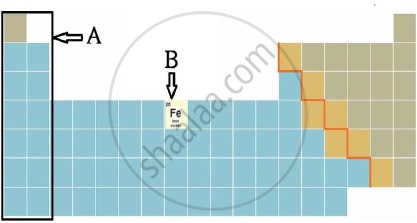Advertisements
Advertisements
Question
3, 1, 2 electrons are in valence shells of X, Y, Z elements. From this information, state the group in which they belong and write their valencies.
Solution
| Valence shell electron(s) |
Group | Valency |
| 3 | 13 | 3 |
| 1 | 1 | 1 |
| 2 | 2 | 2 |
APPEARS IN
RELATED QUESTIONS
Arrange the following as per the instructions given in the brackets:
Cl, F, Br, I (increasing order of electron affinity)
Explain the following:
Group 17 elements are strong non-metals, while group 1 elements are strong metals.
The elements at the bottom of a group would be expected to show ______ metallic character than the element at the top.
Choose the correct answer.
An alkaline earth metal
(i) Lead
(ii) potassium
(iii) calcium
(iv) Copper
iii) Observe the figure and answer the following questions.
a) Identify the block shown by box A and write an electronic configuration of any one element of this block.
b) Identify the block of element denoted by letter B and write its period number.
In Period 3, the most metallic element is ______.
Explain
Larger the atomic size, more metallic is the element.
Supply the missing word from the words given in brackets.
If an element has one electron in its outermost energy level, then it is likely to be _ (metallic, non metallic)
Within a group, where would you expect to find the element with the greatest metallic character.
Use the information given in (a) to (h) to identify the substances P to W selecting your answers from the given list.
List:
| Calcium | Oxygen | Copper (II) Oxide |
| Carbon | Calcium hydroxide | Copper (II) Nitrate |
| Lead (II) Oxide | Hydrogen chloride | Chlorine |
| Lead (II) Nitrate | Calcium Oxide | Ammonium chloride |
- P is white solid. When heated produces white fumes (sublime).
- P and R on warming produce an alkaline gas.
- On adding water to T, heat is evolved and R is formed.
- Q burns brightly in the air to form T.
- When S is heated, it gives off brown fumes and leaves a black residue of U.
- A solution of S is formed by warming U with dilute nitric acid.
- V is a gaseous non-metallic element that reacts with hydrogen to form W.
- A solution of W will neutralize the solution of R.
The metallic character of the element decreases moving across a period from left to the right.
Electronegativity is the metallic property of an element.
Write an Explanation.
Electronegativity
The metal which is hard and has a high melting point and used in filaments of electrical bulbs is ______
An element has atomic number 17. To which group, the period does it belong? It is metal or non-metal?
Which of the following set of elements is written in order of their increasing metallic character?
Which of the following metal (s) do not react with water?
Choose the odd one out and write the reason:
Metals are good ______ because they are electron ______.
